Abstract
The present invention discloses an application of magnesium oxide nanoparticles as an antimicrobial agent, said application being the use of magnesium oxide nanoparticles as a bacteriostatic agent for Candida tropicalis; the magnesium oxide nanoparticles provided by the present invention have the characteristics of non-toxicity, good bacteriostatic efficiency against common beverage microorganisms, and so on, and have the potential to be used as a good antiseptic for acidic beverages, in particular, have obvious inhibitory effect on the acidic beverage In particular, it has obvious bacteriostatic effect on Pseudomonas tropicalis in acidic beverages, and its preparation method is simple, and magnesium oxide powder with different particle sizes can be prepared by controlling the precursor calcination conditions, which is suitable for industrialized production.
Description
Application of nanometer magnesium oxide as antimicrobial agent
(I) Technical Field
The present invention relates to the application of magnesium oxide nanoparticles as antimicrobial agents, specifically, the growth inhibiting effect of magnesium oxide nanoparticles on Candida tropicalis.
(ii) Background technology
Beverages are a necessity in our daily life. Beverages are very susceptible to microbial contamination during processing and marketing due to their rich nutrient content, and for this reason, a certain amount of preservative needs to be added to commercialized beverages. Preservatives are mainly divided into two categories: chemical preservatives and natural preservatives. Chemical preservatives are divided into organic preservatives and inorganic preservatives. The former mainly includes benzoic acid, sorbic acid, etc., the latter mainly includes sulfites and nitrites, etc.. Natural preservatives, usually extracted from the metabolites of animals, plants and microorganisms. Although natural food preservatives are non-toxic and harmless, they are currently expensive and have not yet been applied on a large scale. At present, chemical preservatives, especially benzoic acid and sorbic acid, are still the mainstream in the food and beverage industry. However, with the improvement of people’s health requirements, people are paying more and more attention to the research and application of preservatives.
Nano magnesium oxide particles are a new type of highly functional fine inorganic materials with a wide range of applications in electronics, catalysis, ceramics, food and other fields. Magnesium oxide nanopowder, due to its structural peculiarities, has a large specific area and has certain antibacterial and bactericidal abilities. In the literature Peter K. Stoimnov, Rosalyn L. Klinger, George L. Marchin, and Kenneth J. Klabunde, Langmuir, 2002, 18: 6679-6686, it is stated that magnesium oxide nanopowders with a particle size of about 4 nm and a specific surface of 1000 m2/g The powder adsorbs halogen and adsorbs on the surface of bacteria and spores by electrostatic force, causing the cell wall to be damaged and the liquid inside the cell to flow out, thus achieving the bactericidal effect. At present, there have been many reports on the preparation and antibacterial properties of magnesium oxide nanopowder. The studies on its bacteriostatic properties are focused on the neutral environment, and the zinc oxide nanopowder shows good bacteriostatic effect. There is no report about its application in acidic environment. In addition, magnesium, as a trace element that must be supplemented daily by the human body, is very beneficial to human health. For this reason, magnesium oxide nanopowder is very potential to be a preservative in the field of acidic beverages.
(iii) Content of the invention
The purpose of the present invention is to provide an antimicrobial property of magnesium oxide nanoparticles in acidic beverages, magnesium oxide nanoparticles as inorganic antimicrobial agents for application in the beverage industry, specifically m magnesium oxide particles as an antibacterial agent for Pseudofilus tropicalis (Candida tropicalis).
The technical solution used in the present invention is:
The present invention provides an application of magnesium oxide nanoparticles as an antimicrobial agent, said application being the use of magnesium oxide nanoparticles as a bacteriostatic agent for Pseudomonas tropicalis (Candida tropicalis).
Further, said magnesium oxide nanoparticles have a particle size of 4 to 150 nm.
Further, the mass dosage of said magnesium oxide nanoparticles is 0.02~0.05 mg/ 104 CFU in terms of cell number of Pseudomonas tropicalis strain.
Further, said magnesium oxide nanoparticles were prepared as follows: at room temperature, 1.0~2.0 mol/L aqueous magnesium nitrate solution was added dropwise to 1.0~2.0 mol/L aqueous soluble sodium carbonate solution, and stirred and mixed for 10~30 minutes under 150~250W ultrasonic conditions to obtain an emulsion, and the emulsion was aged at room temperature for 3~5 hours, filtered, washed, freeze-dried, and pulverized, to Basic magnesium carbonate precursor is obtained, and the precursor is warmed to 450~800°C at a rate of 3~10°C/min, calcined for 2~5 hours, and magnesium oxide nanoparticles are obtained; the ratio of the amount of magnesium nitrate in said magnesium nitrate solution to the amount of soluble sodium carbonate in said soluble sodium carbonate solution in the amount of soluble sodium carbonate casting substance is 1:1~1.3.
Further, said application is to use the magnesium oxide nanoparticles as a bacteriostatic agent for Pseudomonas tropicalis in acidic beverages.
Further, said acidic beverage is of pH 2.5 to 5.5.
The nano magnesium oxide particles described in the present invention are made from soluble magnesium salt and soluble carbonate as raw materials, and the alkaline magnesium carbonate precursor is firstly made, and is obtained by controlling the calcination conditions, and it is specifically recommended to be carried out in the following steps: adding 50 ml of aqueous magnesium nitrate solution of 2.0 mol/L to the ultrasonic reaction vessel, and adding 55 ml of aqueous sodium carbonate solution of soluble carbonate with concentration of 2.0 mol/L dropwise at room temperature to obtain a white Emulsion, and then in 250W ultrasonic conditions stirring and mixing for 20 minutes, the emulsion obtained at room temperature aging for 5 hours, filtration, washing, freeze-drying, crushing, alkaline magnesium carbonate precursor, the precursor to 3 ~ 10 ℃ / min speed heating to 450 ~ 800 ℃, calcination 2 ~ 5 hours, can be obtained for the size of 4 ~ 150 nm size of the white nanoparticles of magnesium oxide.
Compared with the prior art, the beneficial effect of the present invention is mainly reflected in:
The nano magnesium oxide particles provided by the present invention have the characteristics of non-toxicity, good bacterial inhibition efficiency against common beverage microorganisms, etc., and have good potential to be used as preservatives for acidic beverages, in particular, they have obvious bacterial inhibition effect against Pseudomallei tropicalis in acidic beverages, and they are easy to prepare, and magnesium oxide particles with different particle sizes can be prepared by controlling the calcination conditions of precursors, which is suitable for industrialized production.
(IV) Description of the accompanying drawings
FIG. 1 Transmission electron micrograph of magnesium oxide nanoparticles prepared in Example 1;
FIG. 2 X-ray diffractogram of magnesium oxide nanoparticles prepared in Example 1;
Figure 3 Inhibitory effect of particle size of magnesium oxide nanoparticles in Example 6 on Pseudomonas tropicalis in apple juice;
Figure 4 Inhibitory effect of particle size of magnesium oxide nanoparticles in Example 6 on Pseudomonas tropicalis in orange juice;
FIG. 5 Bacteriostatic effect of the concentration of magnesium oxide nanoparticles in Example 6 on Pseudomonas tropicalis in apple juice;
Example 1
Preparation of magnesium oxide nanoparticles: 25 ml of 1.0 mol/L aqueous magnesium nitrate solution was added into an ultrasonic reaction vessel (Sonicafier 450, Branson Ultrasonics corporation, USA), and a white emulsion was obtained by dropwise addition of 25 ml of 1.0 mol/L aqueous soluble sodium carbonate solution at room temperature (25°C), which was stirred and mixed for 20 minutes under 250W ultrasonic conditions. 250 W ultrasonic condition with stirring and mixing for 20 min, the obtained emulsion was aged at room temperature for 5 h, and then filtered, the filter cake was washed with water and freeze-dried at -50 °C for 3 h, and pulverized to obtain the alkaline magnesium carbonate precursor, and the precursor was heated up to 450 °C at a rate of 5 °C/min, and calcined for 1.5 h, to obtain the white nanoparticles of magnesium oxide with a particle size of 25 nm. The scanning electron microscopy diagram is shown in Fig. 1, and the X-ray diffraction pattern is shown in Fig. 2.
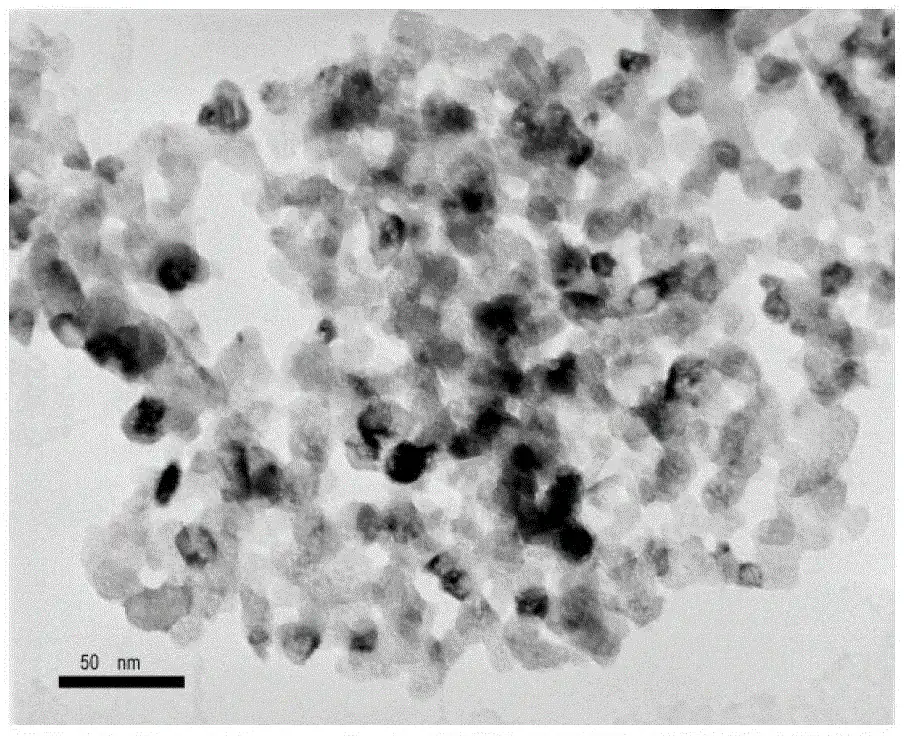
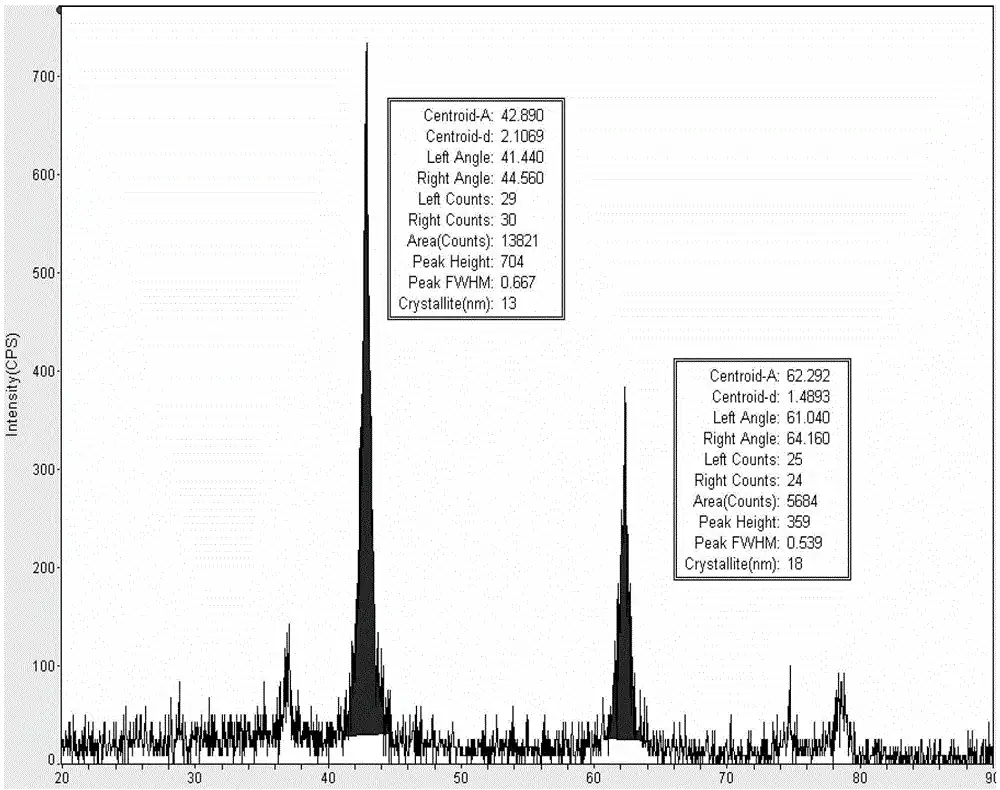
Bacteriostatic properties: the above magnesium oxide nanoparticles and bacterial suspension (106 CFU/mL) were added to apple juice, in which the concentration of bacteria was 104 CFU/mL and the concentration of magnesium oxide nanoparticles was 300 ppm. the samples were stored at room temperature for 21 days, and the samples were sampled every 3 days, and the inhibitory effect was determined by using the plate colony counting. the experimental operation and the preparation of solution were the same as that in Example 6. the results showed that The results showed that no bacterial colonies were detected after 21 days of storage at room temperature.
Example 2
Preparation of magnesium oxide nanoparticles: 1.5 mol/L magnesium nitrate aqueous solution 50 ml was added to the ultrasonic reaction container, 1.0 mol/L soluble sodium carbonate aqueous solution 80 ml was added dropwise to obtain a white emulsion, stirred and mixed under the condition of ultrasonic at 250W for 20 minutes, and then the obtained emulsion was aged for 5 hours at room temperature, filtered, washed, -50 ℃ freeze-dried for 3h, crushed, and then obtained as a precursor of basic magnesium carbonate. The basic magnesium carbonate precursor was calcined at 600 ℃ for 1.5 hours at 5 ℃/min, resulting in white magnesium oxide nanoparticles with a particle size of 50 nm.
Bacteriostatic properties: the above magnesium oxide nanoparticles and bacterial suspension (106 CFU/mL) were added to apple juice, in which the concentration of bacterium was 104 CFU/mL and the concentration of magnesium oxide nanoparticles was 300 ppm. the samples were stored for 21 days at room temperature, and the samples were sampled every 3 days, and the inhibitory effect was determined by using the plate colony counting. the results showed that After 18 days of storage at room temperature, no colonies were detected, and after 21 days, colonies of 101.2 CFU/mL could be detected.
Example 3
Preparation of magnesium oxide nanoparticles: 1.0 mol/L magnesium nitrate aqueous solution of 50 ml was added to the ultrasonic reaction vessel, and the white emulsion was obtained by dropwise addition of 40 ml of aqueous soluble sodium carbonate solution with a concentration of 1.5 mol/L at room temperature, and stirred and mixed under the condition of ultrasonication of 250 W for 20 minutes, and the obtained emulsion was aged for 5 hours at room temperature, filtered, washed, freeze-dried at -50 ℃ for 3 h, crushed and the The alkaline magnesium carbonate precursor was heated to 800 ℃ at 5 ℃/min and calcined for 1.5 hours, resulting in white magnesium oxide nanoparticles with a particle size of 80 nm.
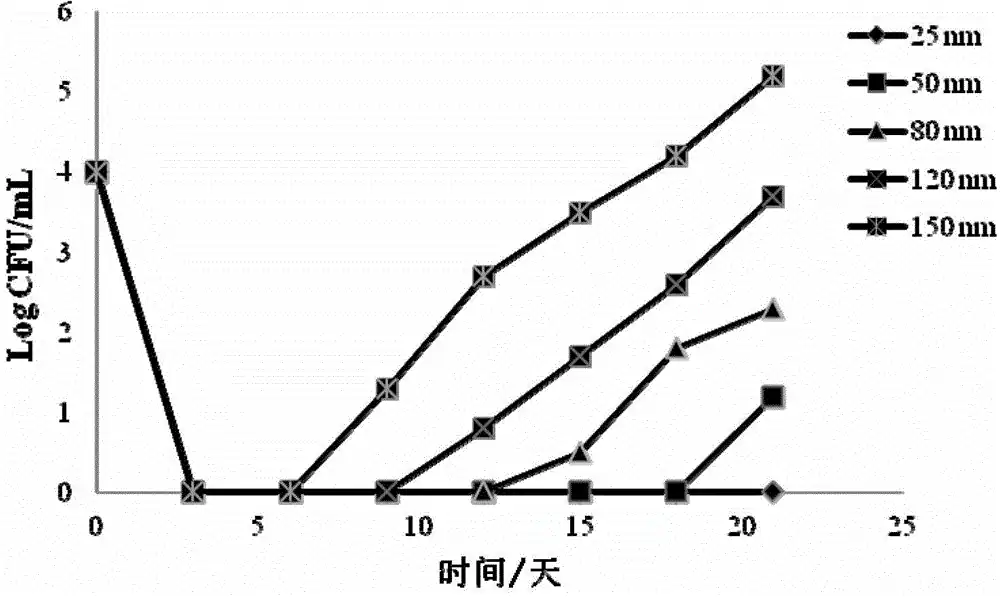
Bacteriostatic properties: the above magnesium oxide nanoparticles and bacterial suspension (106 CFU/mL) were added to orange juice, in which the concentration of bacteria was 104 CFU/mL and the concentration of magnesium oxide nanoparticles was 300 ppm. the samples were stored at room temperature for 21 days, and the samples were sampled every 3 days, and the inhibitory effect was determined by using the plate colony counting. the results show that No colonies were detected after 12 days of storage at room temperature.
Example 4
Preparation of magnesium oxide nanoparticles: add 20 ml of 2.0 mol/L magnesium nitrate aqueous solution to the ultrasonic reaction vessel, add 30 ml of soluble sodium carbonate aqueous solution with a concentration of 1.5 mol/L dropwise at room temperature to obtain a white emulsion, and stir and mix under the condition of ultrasonication of 250W for 20 minutes, and then aging the emulsion obtained for 5 hours at room temperature, filtration, washing, freeze-drying at -50 ℃ for 3h, and pulverization, and the basic magnesium carbonate precursor obtained for 5 hours at room temperature. The obtained basic magnesium carbonate precursor was heated up to 500°C at 5°C/min and calcined for 3 hours to obtain white magnesium oxide nanoparticles with a particle size of 120 nm.
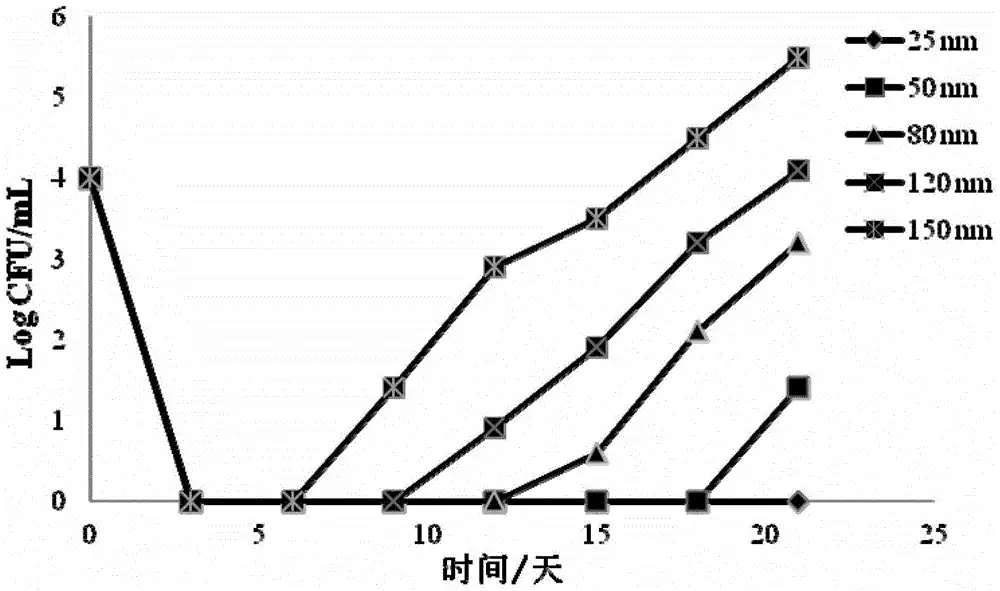
Bacteriostatic properties: the above magnesium oxide nanoparticles and bacterial suspension (106 CFU/mL) were added to orange juice, in which the concentration of bacteria was 104 CFU/mL and the concentration of magnesium oxide nanoparticles was 400 ppm. the samples were stored at room temperature for 21 days, and the samples were sampled every 3 days, and the inhibitory effect was determined by using the plate colony counting. the results showed that After 21 days of storage at room temperature, no bacterial colonies were detected.
Example 5
Preparation of magnesium oxide nanoparticles: 2.0 mol/L magnesium nitrate solution 20 ml was added to an ultrasonic reaction vessel, and a white emulsion was obtained by dropwise addition of 24 ml of aqueous soluble sodium carbonate solution with a concentration of 2.0 mol/L at room temperature, and stirring and mixing for 20 minutes under the ultrasonic condition of 250 W. The obtained emulsion was aged for 5 hours at room temperature, filtered, washed, freeze-dried for 3 h at -50 ℃, crushed and the The obtained basic magnesium carbonate precursor was heated to 600 ℃ at 5 ℃/min and calcined for 5 hours, resulting in white magnesium oxide nanoparticles with a particle size of 150 nm.
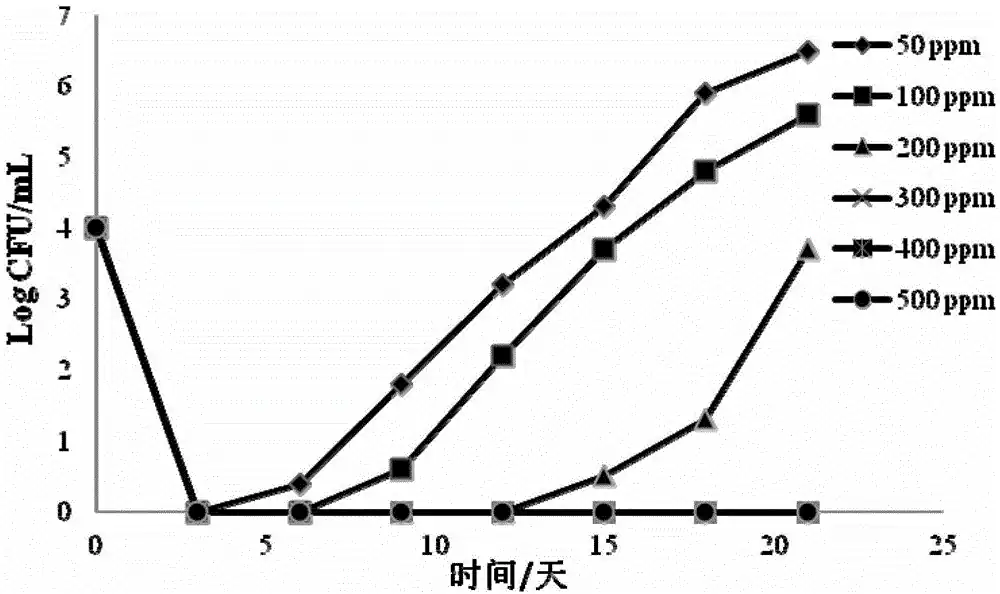
Bacteriostatic properties: the above magnesium oxide nanoparticles and bacterial suspension (106 CFU/mL) were added to orange juice, in which the concentration of bacteria was 104 CFU/mL and the concentration of magnesium oxide nanoparticles was 300 ppm. the samples were stored at room temperature for 21 days, and the samples were sampled every 3 days, and the inhibitory effect was determined by using the plate colony counting. the experimental operation and the preparation of solution were the same as that of Example 6. the results showed that After 6 days of storage at room temperature, no colonies were detected.
Nano-magnesium oxide particles are non-toxic and have good antibacterial efficiency against common beverage microorganisms, and have good potential to be used as a preservative for acidic beverages. The preparation method is simple, magnesium oxide particles of different particle sizes can be prepared by controlling the calcination conditions of the precursor, and is suitable for industrial production.
